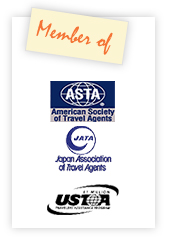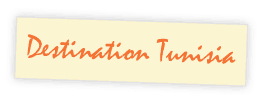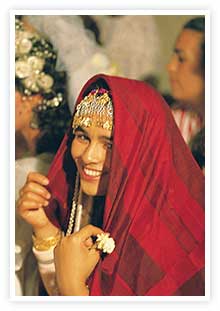| Chinese - Japanese |
  |
The population of Tunisia numbers approximately 9,910,872 inhabitants (2004). The demographic growth rate is 1.21 percent, the lowest on the African continent. ...who represent a rich cultural mix... Arab, Berber, African, and European influences have helped shape the unique Tunisian cultural identity. The overwhelming majority of the population is Muslim, and the official religion is Islam. Christian and Jewish communities practice their faith freely and contribute to Tunisia's rich cultural diversity. The official language is Arabic. French is widely used and English and Italian are spoken among a growing number of Tunisians. ...and are highly urban. Tunisia's population is over 65 percent urban. Tunis, the capital, with a population of nearly 1 million, is one of the key urban centers of the Mediterranean. Other cities in Tunisia include Carthage, Sfax, Sousse, Jerba, Hammamet, Kairouan, Monastir, Tozeur and Tatouine, The National Census carried out by the Tunisian Ministry of Economic Development in 1994 presents this demographic profile:
Tunisia has a huge middle class...
...and a family structure characterized by freedom of opportunity for women. The family remains the basic unit of Tunisian society. With the assistance of public and private institutions, it continues to function as a vital support mechanism for the individual at all stages of life. The resilience of the family structure did not prevent women from gaining a good measure of autonomy and pursuing their own careers on an equal foot with men. The country has focused on developing human resources and a market-oriented economy... Due to its limited natural resources, Tunisia has focused on developing its human resources: the bulk of the national budget has been allocated to education, health care, housing and social services, while a comparatively small amount was spent on defense. The private sector is encouraged to play a leading role in economic growth, and as a result, Tunisians have created a modern, diversified market-oriented economy based on an efficient agricultural sector, a growing manufacturing sector, and a thriving tourism industry. ...which has made it an international model for success. Tunisia's GNP and social indicators have risen steadily since independence. Per capita income has increased sevenfold, from $300 in 1956 to over $2,070 in 1997 to $2,983 in 2004. Tunisia has enjoyed an average growth rate of 5.4 percent since 1987, including 8.6 percent in 1992. Furthermore, even with the world debt crisis, Tunisia has managed to actually reduce its total debt burden. During the last few years, Tunisia has been frequently cited by international financial institutions as a "model for success" in economic structural adjustment. Tunisia's socioeconomic health... In addition to investment in education, health, housing and social protection, Tunisia has undertaken a number of programs to combat poverty. The percentage of the population living below the poverty level has dropped from 33% in 1967 to less than 6 % today. ... is linked to numerous social programs... One notable program is The National Solidarity Fund(FSN), known by its account number "26-26". The fund aims at helping poor areas. The National Program to assist Limited-Income Families was allocated 34 million dollars in 1995. The Social Defense and Integration Program aims to strengthen the family structure as the basic unit of society and to ensure the rehabilitation and social integration of juvenile delinquents. As for child care, special attention is given to foster-family and adoptive children as well as children of divorced or poor parents. ...including the care of elderly and handicapped citizens. Care for Senior Citizens includes direct financial benefits, and the creation of medical home-care units, public nursing homes and health clinics. In addition to a series of special projects for handicapped citizens , practical measures have been enforced to facilitate access to public buildings, sidewalks and public spaces. Hundreds of businesses are legally bound to reserve a 1 % recruitment quota for the handicapped. Health indicators continue to improve. Infant mortality has dropped from the 1985 figure of 51.6 per thousand to that 22.1 per thousand in 2003. According to the statistics of 2003 there is one physician per 1,150 inhabitants and one basic health center per 5,150 inhabitants. Tunisia's experience in family planning has achieved remarkable results as illustrated by the decrease in demographic growth to a rate of 1.21%. Tunisia has always placed great value on education. More than 20 percent of the Government operating budget goes to primary and secondary education, a figure that is among the highest in the world. Education is compulsory for children between the ages of 6 and 16. As a result of the emphasis on education, the net rate of school enrollment for six-year old children exceeds 99.1% against 98% in 1994-95. The net rate of enrollment in primary schools for ages 6 to 11 is 97.2% . The country's six universities (four in Tunis, one in Sousse, and one in Sfax), had a student enrollment of 102,682 during the academic year 1994/1995; whereas, during the 2004/2005 academic year, it amounts 334,000 students. New universities have been set in different specialties throughout the whole country Source : ATCE (Agence Tunisienne de Communication Extérieure)
|
|||||||||||||||||||||||||||||||||||||||||||||


 The structure of Tunisian society is characterized by the predominance of the middle class; nearly 80% of the population are considered middle class. In four decades of development, there has been a continuous rise in the standard of living of Tunisia's citizens thanks to the overall development effort and to the implementation, since 1987, of a series of measures and actions which have promoted business initiative and economic opportunity, and ensured the access of all citizens to basic amenities.
The structure of Tunisian society is characterized by the predominance of the middle class; nearly 80% of the population are considered middle class. In four decades of development, there has been a continuous rise in the standard of living of Tunisia's citizens thanks to the overall development effort and to the implementation, since 1987, of a series of measures and actions which have promoted business initiative and economic opportunity, and ensured the access of all citizens to basic amenities.